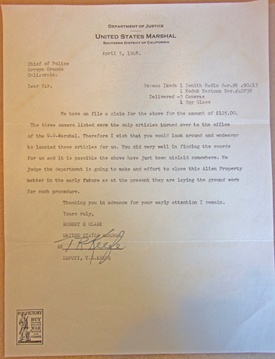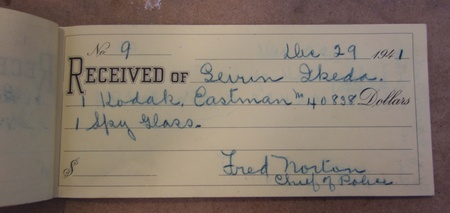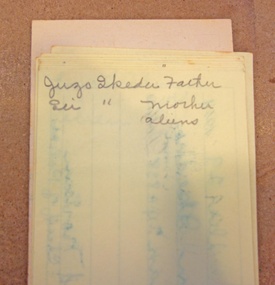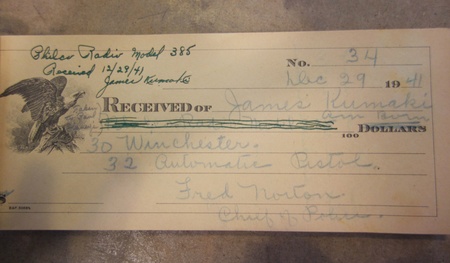If you go to the heart of downtown Arroyo Grande, you will find tucked away in a small house the South County Historical Society. Stored in the house are thousands of documents and other artifacts chronicling the town’s century-and-a-half existence and the lives of its inhabitants. For instance, among the documents in the house is a pair of check registers belonging to the former Chief of Police, Fred Norton. Yet rather than being a record of payments, however, each page in these ledgers has scribbled on it in pencil the name of a Japanese American household in Arroyo Grande and the receipt for a list of objects. The date scrawled in the top right corner is December 29th, 1941. What may seem at first to be an ordinary object in this small-town house can tell a greater story about the history of the United States.
In the weeks following the attack on Pearl Harbor on December 7th, 1941, the US. Department of Justice put into motion a series of orders that broadened the powers of the FBI in order to deal with ‘subversive activity.’ This included the mass arrests of thousands of enemy aliens -non-US citizens of Japanese, German, and Italian origin - and their subsequent confinement by in Department of Justice internment camps. Alongside these arrests were hundreds of warrantless searches conducted by local police departments and the FBI, an action that Attorney General Francis Biddle later confessed proved ineffective in locating subversives, and in fact did more harm than good.
A further action by the Justice Department was to declare certain items as “contraband.” On Saturday, December 27th, 1941, Biddle announced that all enemy aliens were to report to local police stations the following Monday to surrender any radios or cameras in their possession.
On Monday, December 29th, around sixty Japanese American arrived at Arroyo Grande city hall to drop off cameras, radios, guns, and binoculars that were on the prohibited list. Only one non-Japanese alien - an Italian, John Pricco - arrived to deliver a shotgun. It was then that Chief Fred Norton opened his check register and, with the help of his deputies, catalogued each family and the piles of items left behind.
For every family, a page in the registers marked each individual’s name and the inventory of objects given to the police department. Of particular note is the listing on the check receipts of the immigration status of each individual: “citizen” or “alien.” Because the Immigration Act of 1924 and the Alien Land Law of 1913, Japanese immigrants were banned from becoming US citizens and from owning land. Unlike German and Italian immigrants who could naturalize, most Japanese American families had to rely on their children as US citizens for owning property. Thus, when the order arrived on December 29th, most individuals present for the surrender were the children of these families - US citizens - and what started as an order for non-citizens soon broadened to citizens.
A few days later, on January 2nd, 1942, the Arroyo Grande Herald-Recorder lauded the Japanese American community for complying swiftly with the order. Special thanks was given to the president of Arroyo Grande’s Japanese American Citizen League chapter, Karl Taku, for his assistance with the surrender. (The article also noted that no German aliens reported to city hall that day, despite their inclusion in the order, but whether they actually received any word of those orders is highly uncertain.)
Each object received by Fred Norton and his staff was summarily tagged and catalogued, with the promise of their return at “whenever instructions to the effect are received.” Those instructions were not fast in arriving. Instead, two months later, on February 19th, 1942, President Roosevelt issued Executive Order 9066, and set in motion the mass confinement of Japanese Americans in incarceration camps - one of the greatest failures of American civil liberties.
Shortly after, Fred Norton retired from the police department. Ten months later, on November 19, 1942, Arroyo Grande’s new Police Chief, C.A. Mackenzie handed over the confiscated items to the US Marshall’s office of Southern California. However, it was not until the end of the war that the Japanese American families of Arroyo Grande were in a position to reclaim their property.
Whether they actually received them, however, is doubtful.

In the years after 1945, Seirin Ikeda submitted numerous inquiries to the US Marshall’s Office in search of his family’s cameras and radios. In April 1948, the US Marshall’s office wrote the Arroyo Grande police department on behalf of Seirin - over six years after the fact and three years after wars’ end. Failing to receive a clear response, Seirin wrote the City Clerk’s office a year later in October 1949 regarding the whereabouts of his family’s items, of which half went unreported according to the Marshall’s office.
Although a substantial effort has been made by local historians in documenting the history of Japanese Americans on the Central Coast, a number of stories are still to be told. There is more to be said, for example, regarding the experiences of the Japanese American community leading up to the incarceration and the loss of their property. The larger lesson we can take from these check registers is that our small community belongs to a greater history that affected the whole of the United States, and we still need to understand the legacy of this tragedy.
It must be also said that the community of Arroyo Grande also demonstrated the good people are capable of amidst injustice. The publication of articles by the Arroyo Grande Herald-Recorder in support of the Japanese American community - some even appearing days after Pearl Harbor - stand as a light of hope at a time when most California papers chose to target the Japanese American community (According to one historian, the first call for the expulsion of the Japanese American community came from the San Luis Obispo Independent on December 12, 1941). It also accentuates the noted deeds of local individuals such as Vard Loomis - who stepped up to safeguard the farms of Japanese American families during their time in camp, only charging them the dollar he gave to them upon their departure.
Documents like these tell a greater story that is worth remembering, and they are in fact part of what makes history so powerful. The story of these two small books not only brings to light ordinary objects as evidence of history, but helps shape how we think of present-day threats to civil rights that are occurring today.
Special thanks to Arthur Hansen for his help with this article.
*This article was originally published in the San Luis Obispo Tribune on November 24, 2019.
© 2019 Jonathan van Harmelen









